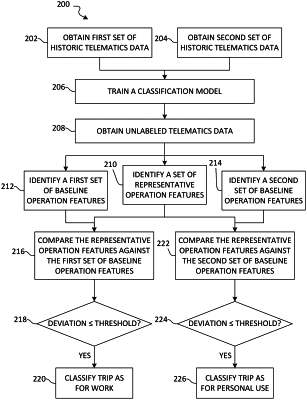| CPC G06Q 10/1091 (2013.01) [G06N 20/00 (2019.01); G06Q 40/08 (2013.01)] | 20 Claims |

|
1. A computer-implemented method for classifying a vehicular trip, the computer-implemented method comprising:
obtaining a first set of historic telematics data associated with a first set of historic vehicular trips during which a vehicle operator operated a first vehicle for work;
obtaining a second set of historic telematics data associated with a second set of historic vehicular trips during which the vehicle operator operated the first vehicle for personal use;
training, by one or more processors, a classification model based at least in part upon the first set of historic telematics data and the second set of historic telematics data, wherein the one or more processors transform the first set of historic telematics data into a set of first feature vectors and the second set of historic telematics data into a set of second feature vectors, wherein the set of first feature vectors and the set of second feature vectors are input into the classification model as training data, and wherein the classification model is trained, such that:
based on receiving an input of feature vectors selected from the set of first feature vectors, the classification model classifies an associated vehicular trip as work; and
based on receiving an input of feature vectors selected from the set of second feature vectors, the classification model classifies an associated vehicular trip as personal use;
obtaining a set of unlabeled telematics data associated with an unlabeled vehicular trip during which the vehicle operator operated an unlabeled vehicle; and
classifying, using the classification model, the unlabeled vehicular trip as work or personal use by at least:
identifying, based at least in part upon the first set of historic telematics data, a first set of baseline operation features associated with the first set of historic vehicular trips;
identifying, based at least in part upon the second set of historic telematics data, a second set of baseline operation features associated with the second set of historic vehicular trips;
identifying, based at least in part upon the set of unlabeled telematics data, a set of representative operation features associated with the unlabeled vehicular trip;
generating, in a feature space, by the one or more processors, a first set of baseline operation feature vectors based at least on the first set of baseline operation features, a second set of baseline operation feature vectors based at least on the second set of baseline operation features, and a set of representative operation feature vectors based at least on the set of representative operation features; and
classifying the unlabeled vehicular trip by at least one of:
based on determining that the set of representative operation feature vectors deviates from the first set of baseline operation feature vectors in the feature space as less than or equal to a first deviation threshold, classifying the unlabeled vehicular trip as work; or
based on determining that the set of representative operation feature vectors deviates from the second set of baseline operation feature vectors in the feature space as less than or equal to the first deviation threshold, classifying the unlabeled vehicular trip as for personal use.
|